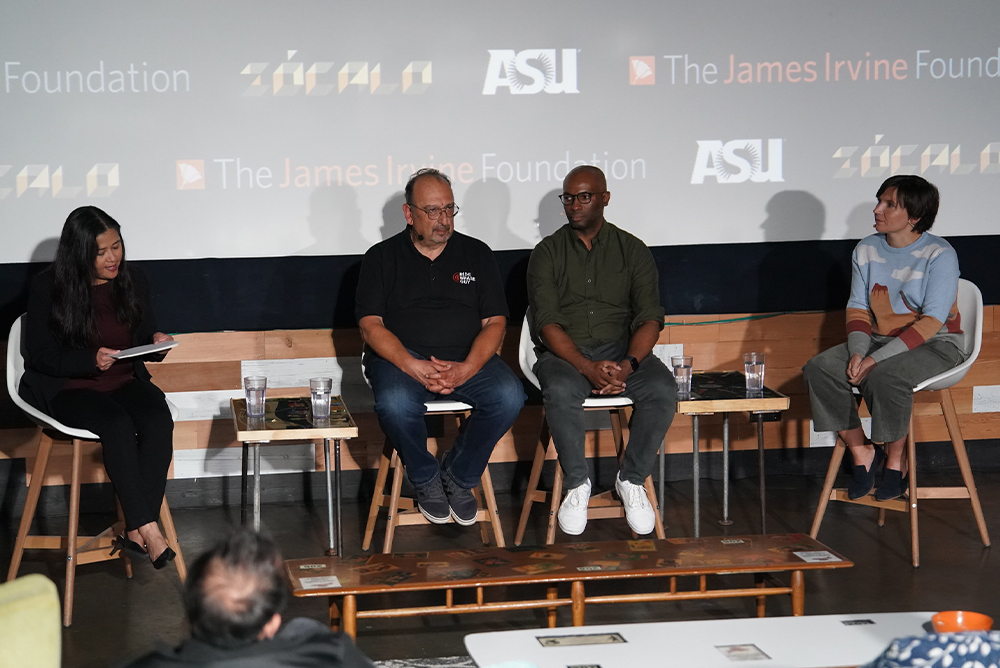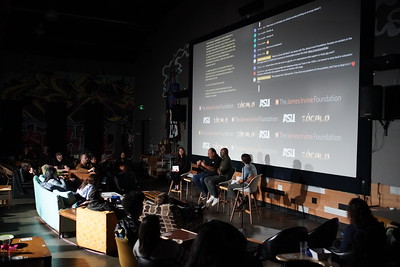
From left to right: Levi Sumagaysay, Sergio Avedian, Allen Narcisse, and Shelly Steward.
In a week when a federal labor rule went into effect making it easier for app-based gig workers to be classified as employees (with significant pushback), and a month after the largest-ever DoorDash, Lyft, and Uber driver strike, Zócalo and The James Irvine Foundation presented “What Is a Good Job Now?” In Gig Work. Part of a series exploring low-wage work across sectors in California, the conversation struck at (and in) the heart of the app-based gig economy: the Bay Area.
The panel took place at the New Parkway Theater in downtown Oakland and featured Sergio Avedian of The Rideshare Guy, Gigs CEO Allen Narcisse, and The Workers Lab chief research officer Shelly Steward. CalMatters economy reporter Levi Sumagaysay, who has covered gig work for over a decade, moderated.
“Uber did not invent freelancing,” Sumagaysay reminded the crowd at the outset of the night. Contract gig work stretches across industries, and has for a long time.
While the app-based companies did revolutionize the way independent contractors gig, with their easy-to-use interfaces, Steward reiterated Sumagaysay’s point. Whether arranged via an app or not, people have always been piecing together full- and part-time work.
“We talk about this idea of traditional work. This vision of a full-time career at one employer with a pension at the end,” said Steward, who researches the intersection of technology and work. “But that was never the norm. It was the norm for white men for a couple of decades in the middle of one century.” Recent technological developments and the modern gig economy have brought visibility to age-old issues for workers.
Narcisse, who worked at Lyft and served as general manager of UberEats, chimed in. Gigs, a company he founded in 2022, lists jobs with varying degrees of flexibility and skill levels, roles for baristas, cashiers, and delivery drivers alike. The point is to help gig workers find quality work. “We focus on the 86 million blue-collar workers in the U.S. and the opportunities they might seek,” he said.
The remaining panelist was Sergio Avedian, a driver with more than 10,000 rides under his belt who had built a following through his advocacy work and as a contributor to the podcast and website The Rideshare Guy. Sumagaysay asked him what the biggest concerns for gig workers are.
The complaints have been the same for the past three or four years, Avedian said: earnings, safety, and unjust firings. Not a day goes by where you don’t hear about a driver being carjacked, shot, or even killed, he said. And when drivers raise concerns—for example, about AI or self-driving cars replacing their jobs—they have no recourse through traditional HR departments and can be unjustly fired.
As for earnings, in 2016 Avedian brought in around $60/hour, which, he pointed out, is what a plumbing contractor might make. Since then, his paychecks have diminished.
Earnings, more and more, are dictated and controlled by the algorithms that app-based companies use to determine and set pricing, Avedian said. He noted that this kind of dynamic pricing is infiltrating many kinds of companies, even a burger chain like Wendy’s—for better or worse, but probably not to workers’ advantage.
These algorithms are related to the gigification of everything, Steward said. Technologies matching people to jobs and customers to services sound great. But if lowering worker conditions and increasing worker risk are necessarily part of the deal—or the whole point of the deal—that’s a problem.
So, why does Avedian continue to drive? Sumagaysay asked. “It’s a fun thing to do,” Avedian said. Besides the fact that he enjoys meeting people, the job has taken him to places in Los Angeles he’s never been, despite having lived there for over 30 years. But, ultimately, Avedian would not recommend anybody take on the gig of a rideshare driver. Yet he understands why people turn to this work.
“What matters is the conditions that they’re facing,” Steward said. Workers want substantial benefits and protections—access to parental leave and workers’ compensation. “This work fits into broader context where both W-2 employment and gig, rideshare, and independent contractor work are suffering a job quality problem.” In other words, bad W-2 jobs are forcing people to turn to rideshare jobs. “We need to lift the floor for all of that work, to give workers more agency and control in their lives.”
The battle has been going on too long, Avedian said, and legislators need to get involved. Lately he has been talking to CEOs and senior leaders of app-based rideshare companies and urging them to drive a mile in his shoes—not just as a PR stunt—and try to really understand the nature of the work.
Is there a happy middle, or a good model out there? Sumagaysay asked.
Avedian pointed to Seattle, Washington. There, a group of drivers created a non-traditional union, the Drivers Union, which got the ear of the city council and convinced it to pass the highest mandated rates for drivers in the country. The group gave up collective bargaining rights but received benefits like paid time off and sick leave. Drivers remained independent contractors, not employees, so many companies like Uber and Lyft came on board.
The work that drivers do is crucial to society, Narcisse said. They fill transportation gaps, including helping fellow hourly workers get to their own gigs. It is important not to lose sight of those bigger impacts of the industry.
As the conversation closed, questions poured in from the online chat and the in-person audience.
One participant posed a big question to Steward: What, then, is the future of work?
Her reply: “The future will be what people will make it.”





Send A Letter To the Editors